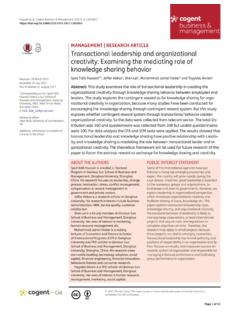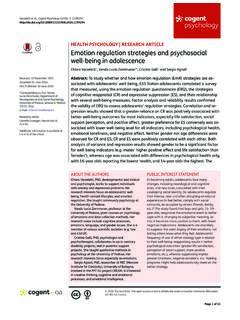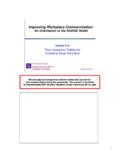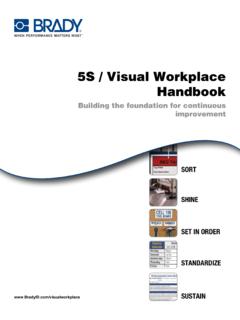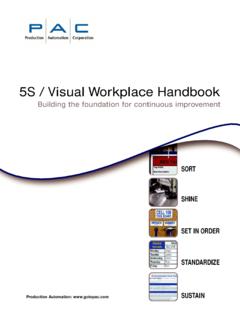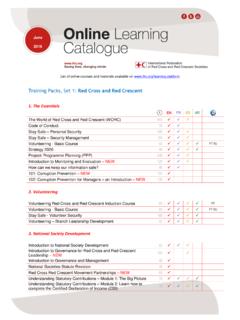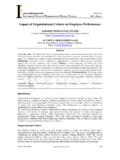Transcription of Workplace diversity and intercultural communication: A ...
1 Evans & Suklun, Cogent Business & Management (2017), 4: 1408943 , INFORMATION & TECHNOLOGY | RESEARCH ARTICLEW orkplace diversity and intercultural communication : A phenomenological studyAdam Evans1* and Harika Suklun2,3 Abstract: For decades, the United States has seen an increasing number of im-migrants, which has led to a significant increase in cultural diversity in the United States. This phenomenological study examines the contextual history of professional non-native English-speaking women in the United States to form a basis of com-parison with native English speakers.
2 It attempts to compare their lived communi-cative experiences with those of non-native English speakers in the Workplace . In this study, 16 professional, native English-speaking women currently working in the US were interviewed. Participants in this study were asked to describe professional and intercultural experiences through interactions with non-native English-speaking coworkers, any expectations of the interactions or violations of those expectations, and any miscommunications that may have occurred. Many native English speak-ers positively reflected upon these intercultural interactions and shared examples of their vocal adjustments and challenges of verbal and intercultural communica-tion.
3 To overcome these challenges, professional native English speakers described trying to slow speech or asking confirming questions such as Do you understand? to mitigate verbal conflicts and miscommunication. Based on the trends within the responses, however, there is a potential for unintentional and often offensive conse-quences to occur. Several coping mechanisms were found to be considered rude or off-putting by non-native speakers, while the intent of a more direct message was often misinterpreted by native English speakers. In addition, it seems that native *Corresponding author: Adam Evans, Business Administration, Transylvania University, Lexington, KY, USAE-mail: editor:Sandy Nunn, Foreign Affairs Council, USAA dditional information is available at the end of the articleABOUT THE AUTHORI have participated substantially in the conception and design of research related to the interpersonal communication in the Workplace .
4 As a native of Turkey and longtime resident of the United States, I have witnessed first-hand the many strategies used by professionals; some were effective and others were not. I hope to increase the effective strategy list through my ongoing research. Especially in current times, the ability to communicate across cultures will only become more vital. That is why through instances such as this work, which specifically takes a look at cultural demographics in the Workplace , we must strive to further our knowledge of effective INTEREST STATEMENTFor decades, the United States has seen an increasing number of immigrants, which has led to a significant increase in cultural diversity in the United States.
5 In this study, 16 professional, native English-speaking women currently working in the US were interviewed. Participants in this study were asked to describe professional and intercultural experiences through interactions with non-native English-speaking coworkers. Many native English speakers positively reflected upon these intercultural interactions and shared examples of their vocal adjustments and challenges of verbal and intercultural communication . Based on the trends within the responses, however, there is a potential for unintentional and often offensive consequences to occur.
6 In addition, it seems that native English speakers often may have good intentions in their actions but do not have the skillset to better facilitate communication with non-native English : 17 August 2017 Accepted: 13 November 2017 First Published: 24 November 2017 2017 The Author(s). This open access article is distributed under a Creative Commons Attribution (CC-BY) 1 of 9 Harika SuklunPage 2 of 9 Evans & Suklun, Cogent Business & Management (2017), 4: 1408943 speakers often may have good intentions in their actions but do not have the skillset to better facilitate communication with non-native English : intercultural communication ; Interpersonal communication ; Human Resource Management; International Business; Organizational StudiesKeywords: communication ; multicultural; Workplace communication .
7 Non-verbal communication1. IntroductionThis study is a continuation of the qualitative study, Professional Immigrant Women in Medium and Large Organizations in the USA: A Phenomenological Study Exploring communication Conflicts that Arise from Language Barriers (Suklun, 2014). diversity initiatives in the Workplace are trending up-ward in 2017 (Biggs, 2015) and improving the language and context of multiculturalism will only increase in importance. Perspectives such as this continuing study may help native English-speaking professional women better understand their non-native English-speaking coworkers.
8 Biggs believes that through conscious practice, we are able to enhance our consciousness to be more in tune with our environment. It is the hope that improved engagement with others will lead to improved rela-tionships and better Workplace visiting a foreign place, individuals attempt to integrate and assimilate into the foreign culture. The desire to fit in and avoiding negative reactions or misunderstandings have often been found to be the motivators for assimilation (Glenn & Kuttner, 2013). For many, the diverse Workplace can also be a challenging new land, adding cultural elements that can complicate communication and understanding.
9 This research focuses on the phenomenon of the interactions between native and non-native English-speaking women based on the experiences of the native English speaker and the growing cultural diversity in organizations in the United the sake of both consistency and comparison, the guidelines utilized in the Suklun (2014) re-search are reflected in this study. However, the primary participant has shifted from non-native English speakers to native English speakers, and an expansion of modern literature focusing on native and non-native approaches to communication have also been integrated to update the former Literature reviewProfessionals often relocate in search of better job opportunities, a trend that has increased in re-cent years (Dewaele & Stavans, 2014).
10 With increased travel, intercultural workplaces and social diversities have also increased (Aneesh, 2012; Breckenridge & Moghaddam, 2012). Developed coun-tries such as the United States have seen a significant growth in multicultural Workplace environ-ments (Oudenhoven & Ward, 2013). Innovations in communication technologies such as Skype and other online mediums have only expedited and facilitated this process, making it easier to create asynchronous, online workplaces that are culturally diverse and globally connected (Biggs, 2015).
